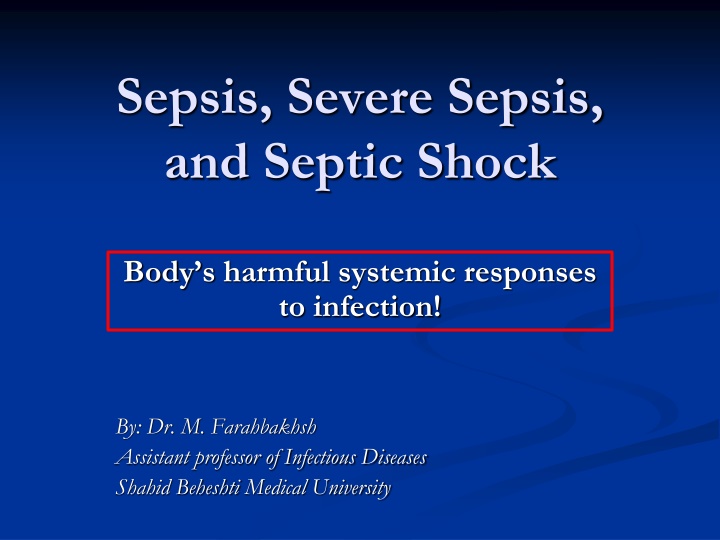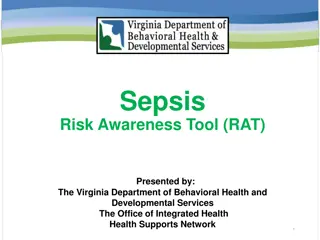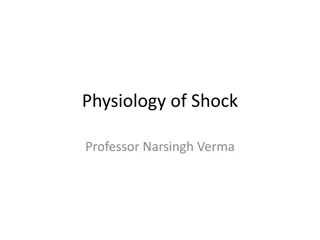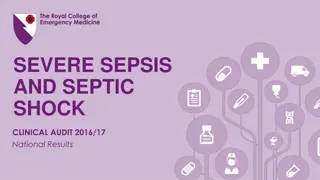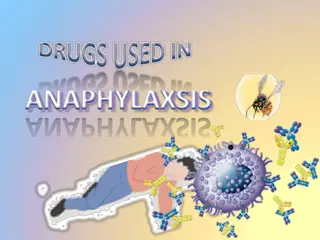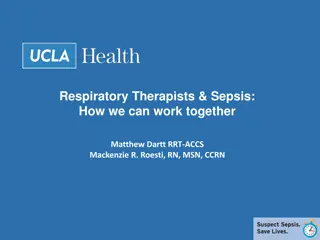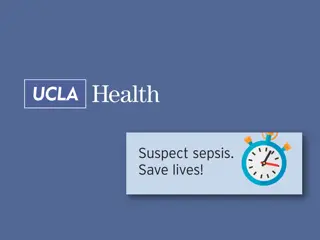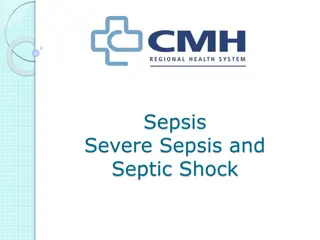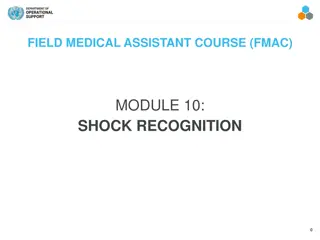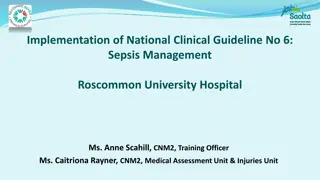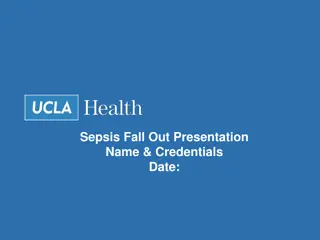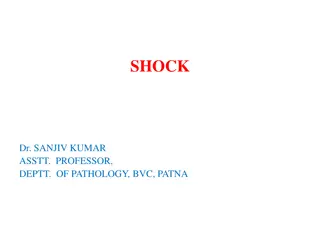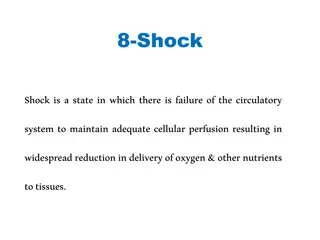Sepsis, Severe Sepsis, and Septic Shock
Body's harmful systemic responses to infection as explained by Dr. M. Farahbakhsh, Assistant Professor of Infectious Diseases at Shahid Beheshti Medical University. Sepsis can progress to severe sepsis with acute organ dysfunction, and further to septic shock marked by hypotension not responding to fluid resuscitation. The incidence of sepsis has increased over the years, with a higher rate in men and nonwhite persons. In-hospital case fatality rates for sepsis-related diagnoses have shown improvement, emphasizing the importance of early recognition and management.
Download Presentation

Please find below an Image/Link to download the presentation.
The content on the website is provided AS IS for your information and personal use only. It may not be sold, licensed, or shared on other websites without obtaining consent from the author.If you encounter any issues during the download, it is possible that the publisher has removed the file from their server.
You are allowed to download the files provided on this website for personal or commercial use, subject to the condition that they are used lawfully. All files are the property of their respective owners.
The content on the website is provided AS IS for your information and personal use only. It may not be sold, licensed, or shared on other websites without obtaining consent from the author.
E N D
Presentation Transcript
Sepsis, Severe Sepsis, and Septic Shock Body s harmful systemic responses to infection! By: Dr. M. Farahbakhsh Assistant professor of Infectious Diseases Shahid Beheshti Medical University
Sepsis, Severe Sepsis, and Septic Shock The systemic inflammatory response syndrome (SIRS) was defined by the presence of two or more acute findings (tachycardia, leukocytosis or leukopenia, fever or hypothermia, tachypnea);
Sepsis, Severe Sepsis, and Septic Shock If SIRS was thought to be caused by presumed or proven infection, the patient was said to have sepsis
Sepsis, Severe Sepsis, and Septic Shock Sepsis is a systemic, deleterious host response to infection leading to severe sepsis (acute organ dysfunction secondary to documented or suspected infection) and Septic shock (severe sepsis plus hypotension not reversed with fluid resuscitation
Sepsis, Severe Sepsis, and Septic Shock 240 cases per 100,000 population per year Increased fourfold during the interval 1979 to 2000. The incidence was higher in men than in women and in nonwhite persons than in white persons
Sepsis, Severe Sepsis, and Septic Shock In-hospital case-fatality rate for patients with a sepsis-related diagnosis fell from 28% to 18%.
Sepsis, Severe Sepsis, and Septic Shock Incidence of severe sepsis increased from 200 cases per 100,000 population 18 years of age or older in 2003 to 300 cases per 100,000 in 2007, or 700,000 cases in the United States
Sepsis, Severe Sepsis, and Septic Shock Median age for patients with a sepsis-related hospital discharge diagnosis is approximately 60 years, The attack rate is very high among infants (more than 500 cases/100,000 population Low-birth-weight newborns experiencing particularly high risk
Sepsis, Severe Sepsis, and Septic Shock
Sepsis, Severe Sepsis, and Septic Shock
Sepsis, Severe Sepsis, and Septic Shock
Sepsis, Severe Sepsis, and Septic Shock Sepsis-related mortality decreases after the first year of life and then increases gradually with increasing age.
Sepsis, Severe Sepsis, and Septic Shock In persons with no known comorbidity, the case-fatality rate is: less than 10% from age 3 to 5 years through the third decade, after which it slowly increases to reach approximately 60% by the seventh decade
Sepsis, Severe Sepsis, and Septic Shock In all age groups, mortality is strongly enhanced by comorbid conditions such as: cancer, diabetes, and immunosuppression.
Sepsis, Severe Sepsis, and Septic Shock Approximately 70% to 80% of the cases of severe sepsis in adults occurred in individuals who were already hospitalized for another reason.
Sepsis, Severe Sepsis, and Septic Shock In 30% to 50% of the cases in these and other series, a definite microbial etiology was not found. Moreover, the microorganism cultured from blood or an infected local site was often one that does not usually cause disease in otherwise healthy people In most cases, it was from the patient s microbiome and may have been acquired during hospitalizationand in approximately one fifth of the patients, more than one isolate was found (polymicrobial infection).
Sepsis, Severe Sepsis, and Septic Shock In most cases, it was from the patient s microbiome and may have been acquired during hospitalization and In approximately one fifth of the patients, more than one isolate was found (polymicrobial infection).
Sepsis, Severe Sepsis, and Septic Shock Respiratory infections most often induce severe sepsis, followed by abdominal and urinary tract infections.
Important steps in microbial pathogenesis Encounter Attachment to host cells Local or general spread in the body (invasion) Cell and tissue damage Evasion of host defenses Shedding from the body 23
Note: Asymptomatic contaminations and normal endogenous flora waits for a SUITABLE situation for invasion. e.g: Staphylococcus aureus in skin that invades soft tissues after an abrasion. 26
Exogenous infections Exogenous infections occur after a direct contamination from microbial populations in the environment: in air, soil and water, in live animals, in other people with infections, and in healthy people who are carriers. 28
in air, soil, food and water Clostridium tetani and Bacillus anthracis Staphylococcus aureus, Clostridium perfringens and Clostridium botulinum, may be present in our food 29
in live animals the so-called zoonoses include brucellosis, rabies 30
in other people with infections human-to-human transmission include the common cold, AIDS, Tuberculosis and 31
in healthy people who are carriers people recovering from typhoid fever may retain Salmonella typhi in the gallbladder 32
GENERAL SIGNS, SYMPTOMS AND CONSEQUENCES OF THE HOST RESPONSE TO INFECTION 33
The classic peripheral signs and symptoms of inflammation (rubor, calor, dolor, tumor and functio laesa redness, heat, pain, swelling and loss of function) commonly go hand in hand with general systemic signs and symptoms such as fever, chills, myalgias, headache and anorexia 34
Fever Infection, Toxins, Inflammatory mediators, Immune reactions Heat saving Heat production Monocytes, Macrophages, Endothelial cells, Heat saving Heat production Pyrogenic cytochines IL-1, IL-6, TNF PGE2 from Hypothalamus Endothelium Temperature set point C AMP 35
: .
Definition H D E E L A Bacteremia Septicemia Sepsis Sever sepsis Septic shock T T H H 40
Definition Bacteremia is defined as growth of bacteria in blood cultures. Almost always Asymptomatic! 41
Definition H D E E L A Bacteremia Septicemia Sepsis Sever sepsis Septic shock T T H H 42
Definition Septicemia is presence of microbes or their toxins in blood. Fever! 43
Definition H D E E L A Bacteremia Septicemia Sepsis Sever sepsis Septic shock T T H H 44
Definition SIRS may be seen in non-infectious conditions. 45
Definition H D E E L A Bacteremia Septicemia Sepsis Sever sepsis Septic shock T T H H 46
Definition Septic shock is defined as severe sepsis in addition to hypotension (systolic blood pressure <90 mm Hg, MAP <70 mm Hg or a decrease of >40 mm Hg from baseline) despite adequate fluid resuscitation 47
Definition H D The term septic is often used informally to describe patients with severe sepsis or septic shock E E L A Bacteremia Septicemia Sepsis Sever sepsis Septic shock T T H H 48
If septic shock lasts for >1 hr and does not respond to pressor administration, the term refractory septic shock is often used. 49
Definition In scientific lexicon, shock results from the widespread failure of the circulatory system to oxygenate and nourish the body adequately. 50
